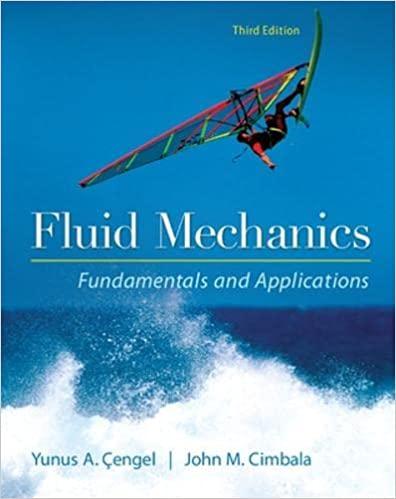Calculate the turbine specific speed of the turbine of Example 1413 for the case where 1 = 10. Provide answers in both dimensionless form
Calculate the turbine specific speed of the turbine of Example 14–13 for the case where α1 = 10°. Provide answers in both dimensionless form and in customary U.S. units. Is it in the normal range for a Francis turbine? If not, what type of turbine would be more appropriate?
Data from Example 14-13
A retrofit Francis radial-flow hydroturbine is being designed to replace an old turbine in a hydroelectric dam. The new turbine must meet the following design restrictions in order to properly couple with the existing setup: The runner inlet radius is r2 = 8.20 ft (2.50 m) and its outlet radius is r1 = 5.80 ft (1.77 m). The runner blade widths are b2 5 3.00 ft (0.914 m) and b1 = 8.60 ft (2.62 m) at the inlet and outlet, respectively. The runner must rotate at ṅ = 120 rpm (ω = 12.57 rad/s) to turn the 60-Hz electric generator. The wicket gates turn the flow by angle α2 = 33° from radial at the runner inlet, and the flow at the runner outlet is to have angle α1 between 210° and 10° from radial (Fig. 14–99) for proper flow through the draft tube. The volume flow rate at design conditions is 9.50 × 106 gpm (599 m3/s), and the gross head provided by the dam is Hgross = 303 ft (92.4 m).
(a) Calculate the inlet and outlet runner blade angles β2 and β1, respectively, and predict the power output and required net head if irreversible losses are neglected for the case with α1 = 10° from radial (with-rotation swirl).
(b) Repeat the calculations for the case with α1 = 0° from radial (no swirl).
(c) Repeat the calculations for the case with α1 = 210° from radial (reverse swirl).
Step by Step Solution
3.37 Rating (166 Votes )
There are 3 Steps involved in it
Step: 1
To calculate the turbine specific speed for the case where 1 10 we use the following equation Ns ns ... View full answer

Get step-by-step solutions from verified subject matter experts
100% Satisfaction Guaranteed-or Get a Refund!
Step: 2Unlock detailed examples and clear explanations to master concepts

Step: 3Unlock to practice, ask and learn with real-world examples

See step-by-step solutions with expert insights and AI powered tools for academic success
-
 Access 30 Million+ textbook solutions.
Access 30 Million+ textbook solutions.
-
 Ask unlimited questions from AI Tutors.
Ask unlimited questions from AI Tutors.
-
 Order free textbooks.
Order free textbooks.
-
 100% Satisfaction Guaranteed-or Get a Refund!
100% Satisfaction Guaranteed-or Get a Refund!
Claim Your Hoodie Now!

Study Smart with AI Flashcards
Access a vast library of flashcards, create your own, and experience a game-changing transformation in how you learn and retain knowledge
Explore Flashcards





